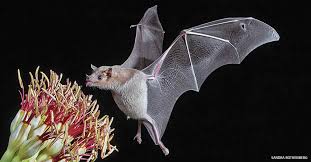
Bats make up one-fifth of the world’s mammal species and are essential to environmental health. There are nearly 1,400 kinds of bats ranging from tiny bumblebee bats weighing less than a U.S. penny to giant flying foxes with nearly six-foot wingspans.
Sadly, global bat populations have been declining by the tens of millions in recent years due to climate change, habitat loss, careless use of wind turbines, and a fungus called white-nose syndrome (WNS).
According to the world’s foremost authority on bats, Merlin Tuttle, other catastrophic factors leading to the demise of bats are cave disturbance and destruction, and some species have even become extinct due to overharvesting. In addition, “They are easily misunderstood and victimized by exaggerated disease speculation, leading to deliberate eradication campaigns with disastrous consequences.”
Most of us are not too knowledgeable when it comes to bats. That’s why the month of October is dedicated to learning about these threatened and underappreciated creatures. We want you to love bats just as much as any of the other threatened pollinators.
Education is Critical
Bats have recently been determined to be America’s most threatened warm-blooded animals and have never needed your help more! https://www.merlintuttle.org/
People won’t protect something they fear or misunderstand. For years, we’ve been led to believe bats were dangerous sources of scary diseases such as Ebola. For nearly a decade, the media and other sources have spread the rumor that bats carried the virus, but evidence now shows humans and other primates transported the deadly disease. It’s the same with our current pandemic. Dr. Tuttle states, “The coronavirus that causes COVID-19 has not been found in bats, and there are no reports of transmission from a bat to a human.”
In reality, bats keep to themselves trying to survive. However, that’s getting more difficult with the loss of their traditional hangouts. Forests, caves, and mines need to be protected to help restore bat populations. For example, both humans and bats love large complex caves and abandoned mines. Unfortunately, sport caving sometimes disturbs bats forcing them to seek shelter in locations where unsuitable temperatures and conditions hamper the rearing of their young during the summer and hibernation in winter. The disturbance isn’t intentional. Instead, folks are not aware of how their actions can negatively affect the cave’s inhabitants.
Through educational programs and activities informing the general public of the bat’s good qualities, progress can be made in helping them. There are plenty of opportunities for bat conservationists and cave explorers to collaborate in identifying, restoring, and protecting key caves and abandoned mines. Also, homeowners can learn how to adapt their backyards to be more bat-friendly and welcome them to the neighborhood.
Helping the Bats
Bats eat bugs. Once we accept them as a beneficial asset to our community, we’ll enjoy having them hanging around. As their natural habitats become more scarce, our yards will play an increasingly significant role in securing the bats’ future.
Bats are a sign of a healthy environment, so landscaping for bats is also good for people.
- Plant a diverse selection of native flowers of varying sizes, shapes, and colors to lure in the bugs. Be sure to include night-blooming plants that’ll attract night-flying insects.
- Don’t forget the trees and shrubs. They’re essential in providing food for insect larvae and adult insects, shelter for flying insects, and roosting opportunities for bats.
- Create a water feature. A small pond or a marshy area provides bats with somewhere to drink and attracts insects that start life as aquatic larvae.
- Linear features such as hedges or tree lines help bats navigate.
- Reduce or remove artificial lighting.
- Refrain from using pesticides.
- Keep cats indoors at night.
With the loss of natural roosting sites, many folks lend a helping hand by installing bat houses. They come in various shapes and sizes and can be placed atop a pole or mounted on a building. You can find bat houses on the internet, but Dr. Tuttle warns that some aren’t well constructed and can injure bats. He explains how to choose a quality bat house here.
A well-made bat house is the first step. Next, you have to choose the best place to install it. Dr. Tuttle and offers these recommendations on selecting the right location:
- Mounting on a post or the side of a house, barn, or shed is best. In particularly cool climates, always opt for a building.
- Even in hot conditions, your bat house should receive 6+ hours of direct sunlight daily. In cooler temperatures, the more sunlight, the better.
- Place the bat house at least 10-12 feet off the ground, 15-20 feet is better. For the best chance of success, make sure it has a clearance of 12 feet beneath the house from any obstacles such as balconies or roofs.
- Locate bat houses at least 20 feet away from trees. Houses mounted on trees offer limited sun exposure and allow predators (primarily owls) to perch on nearby branches. If a tree is your only option, choose a sunny spot far from potential predator perches.
Bats are beautiful, beneficial, and efficient creatures that have been terribly misunderstood for a long time. It’s fun to watch them making low passes across the yard, snatching mosquitoes and then soaring overhead on the prowl for their next bug. They really are good guys. Give them a chance to prove their excellent bug-hunting skills, and then you’ll be happy to welcome them to your yard every evening.
 RSS Feed
RSS Feed

